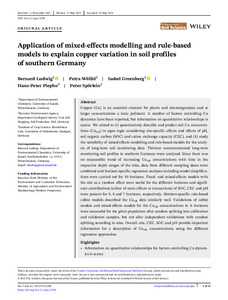| dc.date.accessioned | 2022-09-01T11:16:48Z | |
| dc.date.available | 2022-09-01T11:16:48Z | |
| dc.date.issued | 2022-05-25 | |
| dc.identifier | doi:10.17170/kobra-202206246403 | |
| dc.identifier.uri | http://hdl.handle.net/123456789/14126 | |
| dc.description.sponsorship | Gefördert im Rahmen des Projekts DEAL | ger |
| dc.language.iso | eng | eng |
| dc.rights | Attribution-NonCommercial-NoDerivatives 4.0 International | * |
| dc.rights.uri | http://creativecommons.org/licenses/by-nc-nd/4.0/ | * |
| dc.subject | heavy metals | eng |
| dc.subject | independent validation | eng |
| dc.subject | mixes-effects models | eng |
| dc.subject | pseudo-independent validation | eng |
| dc.subject | rule-based cubist models | eng |
| dc.subject | soil monitoring | eng |
| dc.subject.ddc | 540 | |
| dc.subject.ddc | 550 | |
| dc.subject.ddc | 570 | |
| dc.title | Application of mixed-effects modelling and rule-based models to explain copper variation in soil profiles of southern Germany | eng |
| dc.type | Aufsatz | |
| dcterms.abstract | Copper (Cu) is an essential element for plants and microorganisms and at larger concentrations a toxic pollutant. A number of factors controlling Cu dynamics have been reported, but information on quantitative relationships is scarce. We aimed to (i) quantitatively describe and predict soil Cu concentrations (CuAR) in aqua regia considering site-specific effects and effects of pH, soil organic carbon (SOC) and cation exchange capacity (CEC), and (ii) study the suitability of mixed-effects modelling and rule-based models for the analysis of long-term soil monitoring data. Thirteen uncontaminated long-term monitoring soil profiles in southern Germany were analysed. Since there was no measurable trend of increasing CuAR concentrations with time in the respective depth ranges of the sites, data from different sampling dates were combined and horizon-specific regression analyses including model simplifications were carried out for 10 horizons. Fixed- and mixed-effects models with the site as a random effect were useful for the different horizons and significant contributions (either of main effects or interactions) of SOC, CEC and pH were present for 9, 8 and 7 horizons, respectively. Horizon-specific rule-based cubist models described the CuAR data similarly well. Validations of cubist models and mixed-effects models for the CuAR concentrations in A horizons were successful for the given population after random splitting into calibration and validation samples, but not after independent validations with random splitting according to sites. Overall, site, CEC, SOC and pH provide important information for a description of CuAR concentrations using the different regression approaches.
Highlights
- Information on quantitative relationships for factors controlling Cu dynamics is scarce
- Site, CEC, SOC and pH provide important information for a description of Cu concentrations
- Validations of cubist models and mixed-effects models for A horizons were successful for a closed population of sites | eng |
| dcterms.accessRights | open access | |
| dcterms.creator | Ludwig, Bernard | |
| dcterms.creator | Wölfel, Petra | |
| dcterms.creator | Greenberg, Isabel | |
| dcterms.creator | Piepho, Hans-Peter | |
| dcterms.creator | Spörlein, Peter | |
| dc.relation.doi | doi:10.1111/ejss.13258 | |
| dc.subject.swd | Deutschland | ger |
| dc.subject.swd | Schwermetall | ger |
| dc.subject.swd | Kupfer | ger |
| dc.subject.swd | Gemischtes Modell | ger |
| dc.subject.swd | Validierung | ger |
| dc.subject.swd | Bodenchemie | ger |
| dc.subject.swd | Bodenprofil | ger |
| dc.type.version | publishedVersion | |
| dcterms.source.identifier | eissn:1365-2389 | |
| dcterms.source.issue | Issue 3 | |
| dcterms.source.journal | European Journal of Soil Science (EJSS) | eng |
| dcterms.source.volume | Volume 73 | |
| kup.iskup | false | |
| dcterms.source.articlenumber | e13258 | |


